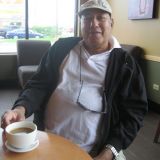Know Stroke/Brain Attack
Stroke is a medical emergency and a leading cause of death in the U.S. It occurs when a blood vessel in the brain bursts or, more commonly, when a blockage develops. Without treatment, cells in the brain quickly begin to die. The result can be serious disability or death. If a loved one is having stroke symptoms, seek emergency medical attention without delay.
Stroke Symptoms
Signs of a stroke may include:
• Sudden numbness or weakness of the body, especially on one side.
• Sudden vision changes in one or both eyes, or difficulty swallowing.
• Sudden, severe headache with unknown cause.
• Sudden problems with dizziness, walking, or balance.
• Sudden confusion, difficulty speaking or understanding others.
Stroke Test: Talk, Wave, Smile
The F.A.S.T. test helps spot symptoms. It stands for:
Face. Ask for a smile. Does one side droop?
Arms. When raised, does one side drift down?
Speech. Can the person repeat a simple sentence? Does he or she have trouble or slur words?
Time. Time is critical
Stroke: Time = Brain Damage
Every second counts when seeking treatment for a stroke. When deprived of oxygen, brain cells begin dying within minutes. There are clot-busting drugs that can curb brain damage, but they have to be used within three hours of the initial stroke symptoms. Once brain tissue has died, the body parts controlled by that area won't work properly. This is why stroke is a top cause of long-term disability.
Diagnosing a Stroke
When someone with stroke symptoms arrives in the ER, the first step is to determine which type of stroke is occurring. There are two main types, and they are not treated the same way. A CT scan can help doctors determine whether the symptoms are coming from a blocked blood vessel or a bleeding one. Additional tests may also be used to find the location of a blood clot or bleeding within the brain.
Ischemic Stroke
The most common type of stroke is known as an ischemic stroke. Nearly nine out of 10 strokes fall into this category. The culprit is a blood clot that obstructs a blood vessel inside the brain. The clot may develop on the spot or travel through the blood from elsewhere in the body.
Hemorrhagic Stroke
Hemorrhagic strokes are less common but far more likely to be fatal. They occur when a weakened blood vessel in the brain bursts. The result is bleeding inside the brain that can be difficult to stop.
'Mini-Stroke' (TIA)
A transient ischemic attack, often called a "mini-stroke," is more like a close call. Blood flow is temporarily impaired to part of the brain, causing symptoms similar to an actual stroke. When the blood flows again, the symptoms disappear. A TIA is a warning sign that a stroke may happen soon. It's critical to see your doctor if you think you've had a TIA. There are therapies to reduce the risk of stroke.
What Causes a Stroke
A common cause of stroke is atherosclerosis -- hardening of the arteries. Plaque made of fat, cholesterol, calcium, and other substances builds up in the arteries, leaving less space for blood to flow. A blood clot may lodge in this narrow space and cause an ischemic stroke. Atherosclerosis also makes it easier for a clot to form. Hemorrhagic strokes often result from uncontrolled high blood pressure that causes a weakened artery to burst.
Risk Factors: Chronic Conditions
Certain chronic conditions increase your risk of stroke. These include:
• High blood pressure
• High cholesterol
• Diabetes
• Obesity
Taking steps to control these conditions may reduce your risk.
Risk Factors: Behaviors
Certain behaviors also increase the risk of stroke:
• Smoking
• Getting too little exercise
• Heavy use of alcohol
Risk Factors: Diet
A poor diet may increase the risk for stroke in a few significant ways. Eating too much fat and cholesterol can lead to arteries that are narrowed by plaque. Too much salt may contribute to high blood pressure. And too many calories can lead to obesity. A diet high in fruits, vegetables, whole grains, and fish may help lower stroke risk.
Risk Factors You Can't Control
Some stroke risk factors are beyond your control, such as getting older or having a family history of strokes. Gender plays a role, too, with men being more likely to have a stroke. However, more stroke deaths occur in women. Finally, race is an important risk factor. African-Americans, Native Americans, and Alaskan Natives are at greater risk compared to people of other ethnicities.
Stroke: Emergency Treatment
For an ischemic stroke, emergency treatmentfocuses on medicine to restore blood flow. A clot-busting medication is highly effective at dissolving clots and minimizing long-term damage, but it must be given within three hours of the onset of symptoms. Hemorrhagic strokes are more difficult to manage. Treatment usually involves attempting to control high blood pressure, bleeding, and brain swelling.
Stroke: Long-Term Damage
Whether a stroke causes long-term damagedepends on its severity and how quickly treatment stabilizes the brain. The type of damage depends on where in the brain the stroke occurs. Common problems after a stroke include numbness in the arms or legs, difficulty walking, vision problems, trouble swallowing, and problems with speech and comprehension. These problems can be permanent, but many people regain most of their abilities.
Stroke Rehab: Speech Therapy
Rehabilitation is the centerpiece of the stroke recovery process. It helps patients regain lost skills and learn to compensate for damage that can't be undone. The goal is to help restore as much independence as possible. For people who have trouble speaking, speech and language therapy is essential. A speech therapist can also help patients who have trouble swallowing.
Stroke Rehab: Physical Therapy
Muscle weakness, as well as balance problems, are very common after a stroke. This can interfere with walking and other daily activities. Physical therapy is an effective way to regain strength, balance, and coordination. For fine motor skills, such as using a knife and fork, writing, and buttoning a shirt, occupational therapy can help
Stroke Rehab: Talk Therapy
It's common for stroke survivors and their loved ones to experience a wide range of intense emotions, such as fear, anger, worry, and grief. A psychologist or mental health counselor can provide strategies for coping with these emotions. A therapist can also watch for signs of depression, which frequently strikes people who are recovering from a stroke.
Stroke Prevention: Lifestyle
People who have had a stroke or TIA can take steps to prevent a recurrence:
• Quit smoking.
• Exercise and maintain a healthy weight.
• Limit alcohol and salt intake.
• Eat a healthier diet with more veggies, fish, and whole grains.
Stroke Prevention: Medications
For people with a high risk of stroke, doctors often recommend medications to lower this risk. Anti-platelet medicines, including aspirin, keep platelets in the blood from sticking together and forming clots. Anti-clotting drugs, such as warfarin, may be needed to help ward off stroke in some patients. Finally, if you have high blood pressure, your doctor will prescribe medication to lower it.
Stroke Prevention: Surgery
In some cases, a stroke results from a narrowed carotid artery -- the blood vessels that travel up each side of the neck to bring blood to the brain. People who have had a mild stroke or TIA due to this problem may benefit from surgery known as carotid endarterectomy. This procedure removes plaque from the lining of the carotid arteries and can prevent additional strokes.
Stroke Prevention: Balloon and Stent
Doctors can also treat a clogged carotid artery without major surgery in some cases. The procedure, called angioplasty, involves temporarily inserting a catheter into the artery and inflating a tiny balloon to widen the area that is narrowed by plaque. A metal tube, called a stent, can be inserted and left in place to keep the artery open.
Life After a Stroke
More than half of people who have a stroke regain the ability to take care of themselves. Those who get clot-busting drugs soon enough may recover completely. And those who experience disability can often learn to function independently through therapy. While the risk of a second stroke is higher at first, this risk drops off over time. more











